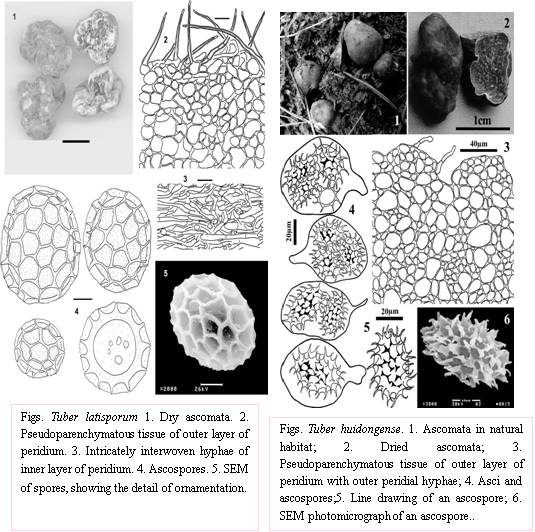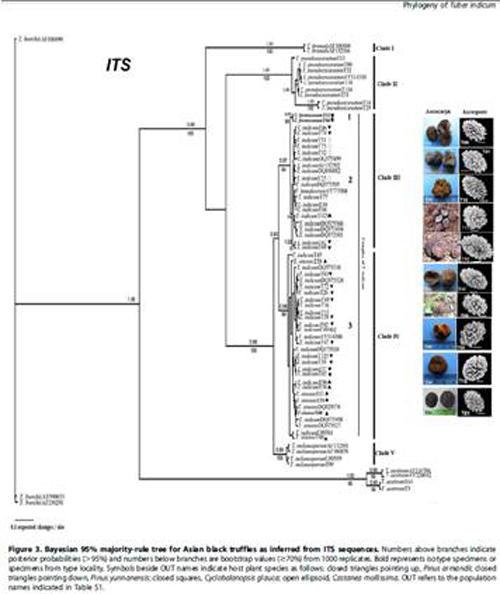Tuber F. H. Wigg. produce subterranean ascomata known as truffles in commercial market andis of great ecological importance and scientific value. Some of them are very popular edible mushrooms and called “black diamond” or “food of God” for their special flavor and high price. In recent years, by the support of the National Natural Science Foundation of China, the Natural Science Foundation of Yunnan Province and the Knowledge Innovation Program of Chinese Academy of Sciences, the research group of systematics and resources of the higher fungi leaded by professor LIU Peigui have been doing studies on taxonomy, molecular phylogeny, mycorrhizal synthesis and microbial diversity of mycorrhizosphere of Tuber from China since 2001. The results confirmed 16 species occur in China, including two new species (T. umbilicatum and T. latisporum) and two new recodes from China (T. excavatum and T. borchii var. sphaerosperma) (Chen et al., 2005; 2007; 2008). T. furfuraceum was synonymized with T. huidongense based on ITS analysis and comparative study on morphology (Deng et al. 2009). The Asian black truffles, Tuber himalayense,T. indicum,T.sinense,T.pseudohimalayense,T. formosanum and T. pseudoexcavatum, were affinitive and confusable. We analyzed three nrDNA (LSU、ITS, b-tubulin) of those five species and compared morphological characters as well as long time of field works to show that T. pseudohimalayens and T.pseudoexcavatum are the same species. T.sinense should be treated as a synonym of T.indicum. T. formosanum is a separate species based on its host plants and geographic distribution, combined with minor character morphological difference from T. indicum. T.indicum includes at least two phylogenetic species in molecular trees (Chen et al. 2011).
We collected many unrecorded species of white truffles with special flavour in recent years. Molecular phylogenetic and morphological analyses show there are at least five or six new species and demonstrated those species are similar with but different from species in Tuber Sect. Puberulum and Sect. Borchii. The supplement of diverse white truffles discovered from south-western China could promote the studies on origin and historical biogeography of genus Tuber (results unpublished).
In field investigation, it shocked us that invasive plant Eupatorium adenophorum were inhibited or killed in the brûlé where Tuber ascomata occur. E. adenophorum are vesicular-arbuscular (VA) mycorrhizaed plant. Theywere inhibited or killed because VA mycorrhizae are in poor condition. The VA mycorrhizae of E. adenophorum in and out of the brûlé were compared preliminarily in 2009. The results indicate VA mycorrhizae of E. adenophorum in brûlé are less abundant and some were even non-infected. The more studies in 2010 show VA mycorrhizae of E. adenophorum in brûlé are less 50%, which indicates the exudates and metabolites secreted from Tuber ascomata could inhibit infection and development of VA mycorrhizae of E. adenophorum. To our knowledge, grasses in brûlé of T. melnonosporum,also known as a burned area, were wilted or killed. The explanations for this phenomenon, such asmicro-flora hypothesis, are not convincing. The inhibition of mycorrhizae may be a reasonable explanation for the “burned area”. To verify our hypothesis, the next work is to collect VA spores and compare diversity of VA fungi in and out of the brûlé. (Related works are in progress) .
As the mycorrhizal fungi, the development of Tuber is influenced by soil microbe.Synthesis of qualified mycorrhizae of Tuber before planting truffle-infected seeding ensures the success of building truffle plantation. Many studies have been done on factors influencing mycorrhizal synthesis oftruffle, such as pH, Ca and substrates. There is little knowledge on influences of microbe in synthesizing Tuber mycorrhizae. We cultured and purified several bacteria from T. indicum mycorrhizosphere, then add in substrates when seedings are inoculating with aqueous spore suspension of T. indicum. After counting mycorrhizae, we found some of them, such as Bacillus thuringiensis, improve infection and increase number of Tuber indicum mycorrhizae. Adding antibiotics in aqueous spore suspension of T. indicum decrease number of mycorrhizae. We confer that antibiotics make microbe in aqueous spore suspension ineffective in forming mycorrhizae (the results unpublished).
Some Tuber spp. is very popular edible mushrooms in market. Their price surged year by year for the world great market demands. Truffles become main economic resource in some remote mountain forest areas. In pursuit of more benefit, more immature and small ascomata which have less perfume and nutrient value had been collected. It is un-scientific in traditional way to collect truffles. Truffle collectors often use hoes and prong to dig all over the Forest Mountains, destroying mycorrhizae and local ecological environment. Mycorrhizae are undertaking responsibilities to communicate the nutrient and information between the truffles and their hosts. It is hard to restore once destroyed. Extensive and predatory collection decrease mature ascoscarp quantity, minimize population of truffles and create economic losses. Truffles in some area are confronted with the risks of extinction! In addition, there are no any laws or rules to protect and promote sustainable use truffles. Truffles are under threats of extinct and it is urgent to save endangered truffles. Building truffle plantation is a good way to reduce the pressure of natural resources. Our group has succeeded in inoculating Tuber indicum in the evtomycorrhizal seedling of the Pinus armandii and Castanea mollissima and acquire Chinese national patent, published relative information (Geng et al. 2009). Truffle-infected seedlings have been transplanted in some suitable mountain experiment field. We expect to begin to produce a few truffle ascomata after 4-5 years and have some harvest after 8-10 years. The soil, vegetation and climate of southwest of China are suitable to produce truffle. It has huge potential to build truffle planation, even though the beginnings of planting truffle and effective management after transplanting make it hard to promote truffle planation.





Truffle-infected seedings in greenhouse truffle planation




